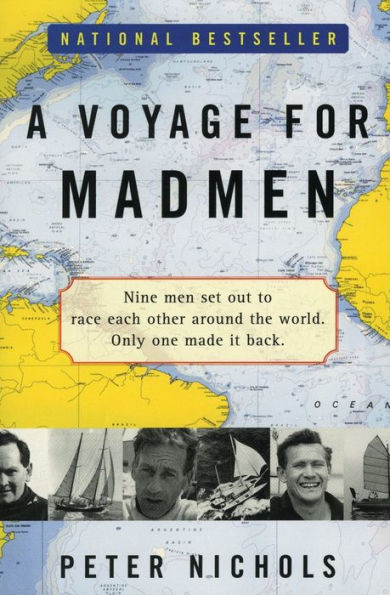Read an Excerpt
In 1966-1967, A 65-year-old Englishman, Francis Chichester, sailed alone around the world. He stopped only once, in Australia.
A tall, thin, balding man with thick-lensed glasses, Chichester looked more like a prep school headmaster than an adventurer. He owned a small book and map store in London. He was a vegetarian. But the urge to subject himself to extreme tests characterized his life. In his youth he made a pioneering flight in a small aircraft from England to Australia. In 1960, at the age of 59, he and four friends made a wager to race each other single-handedly in their four very different boats across the Atlantic. The course began at Plymouth's Eddystone Lighthouse and finished at the Ambrose light vessel off New York Harbor; the route between these two points was up to the racers. There were no other rules. The winner would receive half a crown.
Francis Chichester won the bet and the race. Sailing his 39-foot sloop Gypsy Moth III, the largest boat of the five, he made Ambrose in 40 days. But winning was not enough; he thought he could do it faster. Two years later, racing nobody but himself, he crossed the Atlantic again, cutting more than 6 days off his earlier voyage. Still he was not happy with his time; he believed a crossing of less than 30 days was possible.
The London Observer had covered the 1960 race and found that it owned a story with major and growing public interest. Four years later, in 1964, the Observer sponsored a second single-handed transatlantic race (now famously known by its acronym, OSTAR). Ten additional competitors joined the original group. One of the newcomers, the Frenchman Eric Tabarly, trounced the fleet and took the honors in 27 days, 3 hours, 56 minutes. Chichester came second, 20 hours and 1 minute later. He beat his personal target time handily, but second was a new place for him, an ignominious position for a lone adventurer.
Tabarly was awarded the Legion of Honor and became a national hero in France: "Thanks to him it is the French flag that triumphs in the longest and most spectacular race on that ocean which the Anglo-Saxons consider as their special domain," proclaimed the Paris Jour.
Single-handed racing hit the big time. National pride on both sides of the English Channel, from two nations famous for their sense of superiority, xenophobia, and rivalry, now focused on the third OSTAR, due to be held in 1968. At least forty sailors announced plans to compete. Many had new, experimental craft designed and built solely for the purpose of winning that one race. Eric Tabarly was building a new 67-foot trimaran, capable of tremendous speeds; at the time this was a radical reappraisal of the size of boat one person could handle. These boats, with their size and gear and engineering, became so expensive that they were beyond the reach of ordinary sailors. Yacht racing began to resemble motor racing, and the long, increasingly ugly hulls were plastered with commercial logos.
A few sailors felt this was veering too far from the notion of "sport." They wrote disapproving letters to yachting magazines, dropped away, and left the field to younger sailors who were learning to navigate the tide rips and currents of commercial sponsorship.
Chichester decided not to compete with the pack in 1968. He would be up against younger men sailing larger boats, and the outcome must have been clear to him: he would be the game old campaigner who would manage a respectable placing halfway through the fleet. He quietly set off to do something else.
Sailing alone around the world was nothing new. The Nova Scotian-born American Joshua Slocum, a sailing ship master beached in his middle years by the steam age, was the first to do it, in 1895-1898. He sailed from Gloucester, Massachusetts, west-about around the globe, against ferocious prevailing winds through the Strait of Magellan, north of Cape Horn, in a seemingly unhandy, fat-hulled, engineless old oystering sloop that he had rebuilt himself and christened Spray. The Spray's seagoing abilities, and what Slocum managed to do with her, have been wondered at and argued over by sailors ever since. Slocum (who couldn't swim and nearly drowned trying to set an anchor off the Uruguayan coast) stopped in many places and wrote a drily humorous yet thrilling book of his adventure, Sailing Alone Around the World. One hundred years later it is still the standard by which all other sailing narratives are gauged.
Eighteen other men had circumnavigated alone by the time Chichester set out in 1967, but his voyage caught the public imagination as perhaps none other since Slocum's. It was no pleasure cruise. His route was down the Atlantic, east-about around the bottom of the world, back up the Atlantic. Virtually all the east-to-west part of his circumnavigation took place in a sea not found on most atlases but infamously known to all sailors as the Southern Ocean: the windswept southerly wastes of the Atlantic, Pacific, and Indian Oceans between latitudes 40 and 60 degrees south, between the habitable world and the Antarctic, where storm-force westerly winds develop and drive huge seas around the globe, unimpeded by land except at one fearsome place, Cape Horn, the southernmost rock of the Andes, the scorpion-tail tip of South America.
Sailors have respectfully and fearfully labeled the latitudes of this global band of turbulent water the Roaring Forties, the Furious Fifties, the Screaming Sixties. The tea clippers from India and China and the square-rigged grain ships from Australia took this route back to Europe because, blown by the westerlies through the desolate seas of the Forties and Fifties, circling the planet at a short, high latitude, it was the fastest way around the world.
But it took sailors through the most isolated area of the globe, the emptiest expanse of ocean, the remotest place from land.



